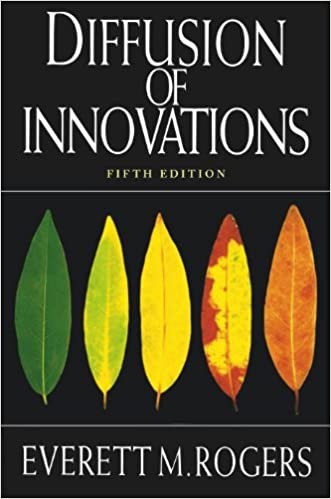
The Diffusion of Innovation (5th ed) by Everett M. Rogers is THE book for anyone who wants to understand this phenomena. This is the 2003 version, but it is still very current. I used this book a lot when I was doing my dissertation and revisit the concepts via this summary from time to time. This is my longest book summary so it may take more than one sitting to finish it. I think it will be work your time.
Chapter 1 – Elements of Diffusion
- Getting a new idea adopted, even when it has obvious advantages is difficult. Therefore, a common problem for individuals and organizations is how to speed up the rate of diffusion of an innovation. Diffusion is a process in which an innovation is communicated through certain channels over time among the members of a social system. A degree of uncertainty is involved and the process can be planned or spontaneous. It results in one kind of social change and leads to certain consequences.
Element 1
- 1) The innovation: It is an idea, practice, or object that is perceived as new. If it seems new, it is an innovation. The adoption process is an information seeking and processing activity in which an individual is motivated to reduce uncertainty about the advantages and disadvantages of an innovation. The characteristics of innovations, as perceived by individuals, help explain their different rates of adoption.
/li>
Element 2
- 2) Communication Channels: The essence of the diffusion process is the information exchange through which one individual communicates a new idea to others. Mass media channels are usually the most rapid and efficient means of informing an audience. Interpersonal channels involve face-to-face exchanges. A third form involves the interactions between individuals via the Internet.
Element 3
- 3) Time: The inclusion of time in diffusion research is one of its strengths. The five steps in the process are: knowledge, persuasion, decision, implementation, and confirmation. There are five adopter categories that are time-based. The first adopters are called innovators. They are followed in time by early adopters, the early majority, the late majority, and laggards. When the number of adopters is plotted over time, an S-shaped curve results.
Element 4
- 4) A Social System: This is a set of interrelated units that are engaged in joint problem solving to accomplish a common goal. Social systems have structure that gives regularity and stability to human behavior (norms). It allows one to predict behavior with some degree of accuracy. The communication in a system also has a structure. Knowledge of the system’s structure is necessary if one wishes to study diffusion within the system.
Some History
- A series of independent groups started this research in the 1940’s and 1950’s. Each group was invisible to the others and used different approaches. They all, however, found the diffusion followed an S-shaped curve and the innovators had higher socioeconomic status than did later adopters. By the late 1960’s the independent groups had come together as shown by the increase in cross-tradition citations.
Gabriel Tarde
- Tarde was a French lawyer and judge around 1900. He observed that for every ten new ideas that spread, ninety will be forgotten. He also observed that the rate of imitation usually followed an S-shaped curve and that the takeoff in the curve begins to occur when the opinion leaders in a system use a new idea. Forty years later his observations were put to the test by empirical research.
The Nine Major Diffusion Research Traditions
- 1) Anthropology – The study of how tribes or villages use technological ideas such as the steel ax, horses, and boiling water.
- 2) Rural Sociology – The study of how farmers in rural communities adopt agricultural ideas such as weed sprays, hybrid seed, and fertilizers.
- 3) Education – The study of school systems, teachers, or administrators as they adopt teaching/learning innovations like kindergarten, modern math, programmed instruction, and team teaching.
- 4) Public Health and Medical Sociology – The study of individuals or organizations such as hospitals and health departments as they adopt medical and health ideas like drugs, vaccinations, family-planning, and AIDS prevention.
- 5) Communication – The study of individuals and organizations as they adopt technological innovations and new communications technology.
- 6) Marketing and Management – They study of individual consumers as they adopt new products.
- 7) Geography – The study of individuals and organizations as they adopt technological innovations.
- 8) General Sociology – The study of individuals and other units as they adopt a wide variety of ideas.
- 9) Early Sociology – The study of communities or individuals as they adopt things like city manager government, postage stamps, and ham radios.
- Other traditions include economics, public administration, political science, psychology, industrial engineering, statistics, and others.
A Word About Education
- Unlike some fields, innovations adopted by education are done so by organizations rather than individuals. Early studies were carried out by Paul Mort at Columbia University. He found that the best single predictor of innovativeness was expenditure per student. The stereotype of the rich suburban school as highly innovative was largely confirmed. Mort found that considerable time lags were required. It took kindergartens about 50 years to be completely adopted. Driver training needed only 18 years while modern math needed only 5 years. Both were promoted by change agencies. The insurance companies and auto manufacturers in the case of driver training and the National Science Foundation for modern math.
DrDougGreen.com If you like the summary, buy the book





